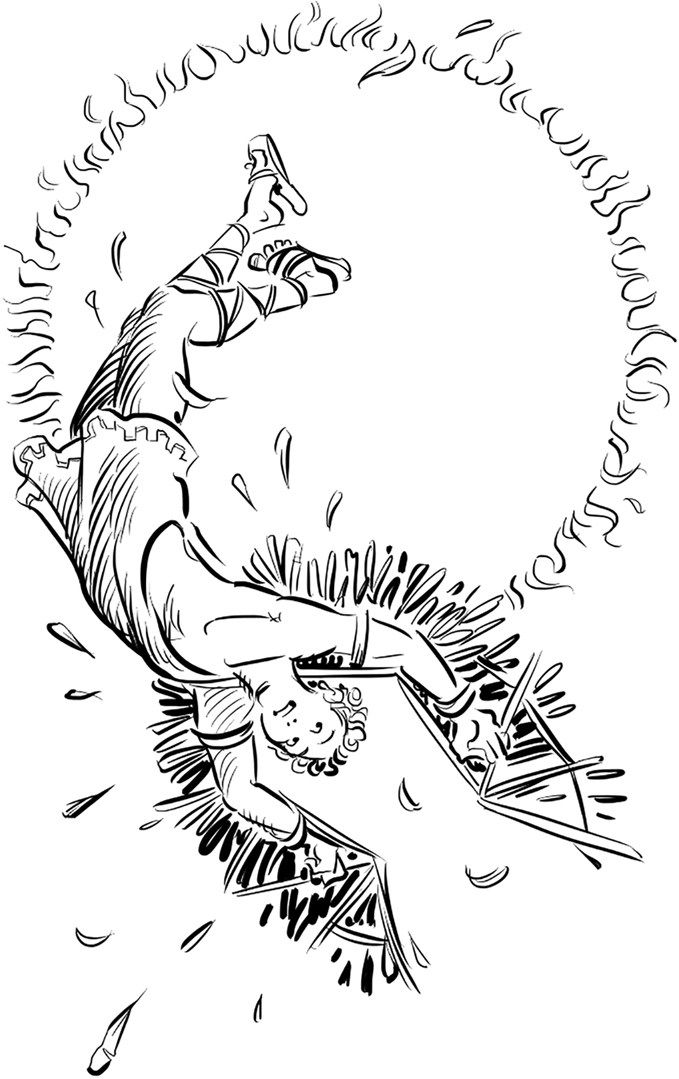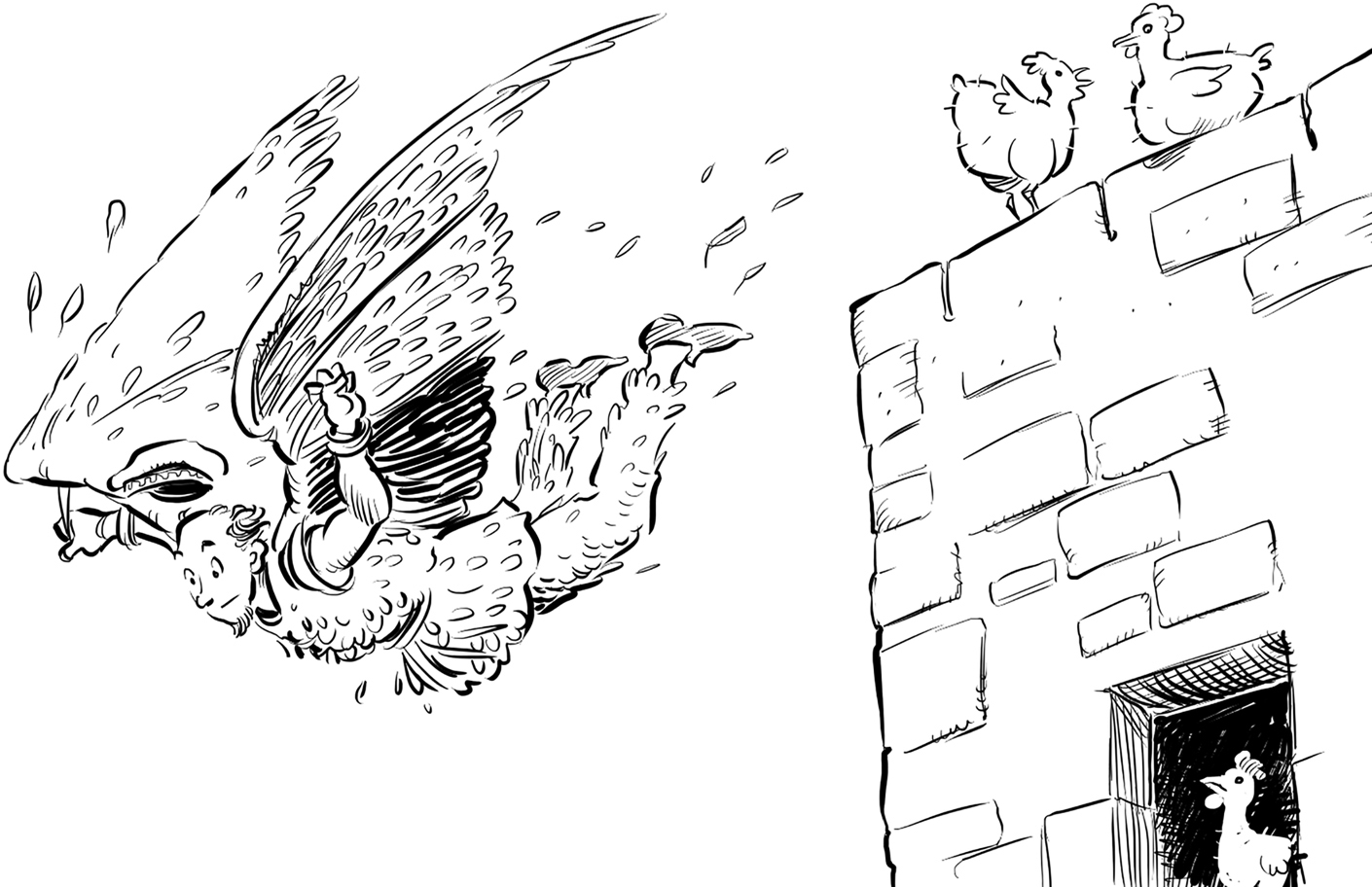CHAPTER 1
Learning to Fall
500 BCE–1665 CE
“There is an art to flying … The knack lies in learning how to throw yourself at the ground and miss.”
—Douglas Adams (Life, the Universe and Everything)


Since the dawn of time, mankind has looked to the skies and dreamed of doing the impossible: soaring effortlessly through the air with the grace of a bird, banking and gliding hundreds of feet above the Earth. It’s a dream humans have clung to since the beginning of written language, dating back to the ancient Greek myth of Icarus, a tale about a boy who was able to escape the tower of an evil king by flying out his prison window on a pair of birdlike wings his father built for him out of feathers and wax.
Of course, Icarus was also the earliest recorded Epic Fail of human flight. Because he was having so much fun flying around like a maniac, Icarus climbed too high in the sky, and the sun melted the wax holding his feathered wings together. The wings disintegrated, and Icarus plummeted hundreds of feet to his untimely death. People today still use the expression “don’t fly too close to the sun” when they try to warn you not to do something stupid.
Despite the cautionary tale of Icarus, people still tried to figure out how to make a man fly. As you might have noticed, this isn’t a particularly easy thing to do. Humans aren’t really designed to fly through the air like beakless pterodactyls. We don’t have wings, we don’t have jetpacks embedded in our feet, we aren’t particularly graceful animals, and we don’t draw power from Earth’s yellow sun as Superman does when he flies. So where do you start?


In 852 CE a daredevil inventor named Armen Firman tried to get it done straight up Icarus-style. He put on a huge cloak with wooden struts holding it open (it kind of looked like a wingsuit), wallpapered it in feathers, and jumped off the tallest tower in Córdoba, Spain. Much to his surprise, but to no one else’s, he plummeted to the ground almost immediately. As he was falling, however, something interesting happened—his homemade glider caught the wind for a moment, and it actually slowed his fall a little. It didn’t slow Armen down enough that he didn’t break nearly every bone in his body, but sometimes making discoveries can be quite painful.
This wacky stunt inspired a scholar named Abbas Ibn Firnas to spend his life pursuing what it would really take to glide in the wind. Abbas was a Muslim mathematician, engineer, chemist, and inventor who had designed everything from water clocks to astronomical star charts. Abbas may have witnessed Armen Firman’s flight (in fact, the history here is so sketchy that he and Firman might have even been the same guy) and decided to spend the next several decades studying the flight of birds, their wingspans, and their graceful movements through the air.
At the age of sixty-five, a full twenty-three years after Armen Firman’s “flight,” Abbas Ibn Firnas constructed a glider of silk, wood, and vulture feathers; ignored the naysayers who told him he was just going to splat himself like a water balloon; and made his way to the tallest cliff he could find. Fueled by determination, and with a large crowd from Córdoba watching from a nearby cliff, Abbas Ibn Firnas got a running start and took a flying leap of faith.
To the shock and surprise of the onlookers, Abbas Ibn Firnas did not immediately fall screaming to a painful death below. Instead, he glided through the air, soaring like a bird for an impressive amount of time. But Abbas’s elation soon gave way to a pressing concern … because despite all the work he’d put into figuring out taking off and gliding through the air, he hadn’t put much thought into how to actually maneuver the glider—or, perhaps more important, how to land it. Without any control over his descent, the poor guy came crashing to the ground like an oversize paper airplane.
Ibn Firnas did survive his unfortunate crash, but he hurt his back so badly he would walk with a limp for the rest of his life and never tried to fly again. Nowadays, there’s a crater on the moon named after him, in honor of his achievement—although possibly in homage to the crater he left when he smacked into the ground like Wile E. Coyote.
Over the centuries that followed, others kept the dream of flight alive, but with little success. An English monk named Roger Bacon hypothesized the possibility of a “flying engine” in 1260, but he never actually built one. In the 1300s Italian explorer Marco Polo wrote of Chinese kites that could hoist a man into the air, although he didn’t bring one of those kites back to Europe and was known for making up more than a few details about his trips, so who knows. In 1507 Italian John Damian covered himself in chicken feathers and tried to fly off Stirling Castle in Scotland, but no matter how hard he flapped his arms, he just rocketed toward the ground like a big flesh-colored rock. It wasn’t a soft landing for poor Mr. Damian.
It would seem that before man would learn to fly, he’d have to learn how to fall. And probably also how to land.
